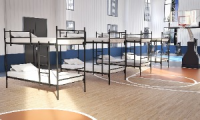
Bunk Bed Manufacturers
Estados Unidos
55 funcionários
Descrição da empresa
Ver tradução
One of the greatest challenges for any bunk bed manufacturers is designing solutions that can withstand prolonged use in high-traffic environments while also being fast to assemble and transport. In countries like Kenya, Chile, and Uzbekistan, where beds are required in bulk for school dormitories or post-disaster shelters, assembly time can make or break a deployment operation. To address this, modern bed manufacturers—including Fano—have begun engineering knock-down systems that can be assembled without welding or complex tools. These beds utilize modular brackets, coded bolt systems, and labeled panels, allowing two workers to fully assemble one unit in less than 15 minutes. What’s more, these models are frequently designed with flat-pack packaging in mind, optimizing space for global shipping in standard 40-foot HC containers. For example, depending on the model, up to 400 disassembled beds can be fitted into a single container, offering a major cost advantage in transportation-heavy operations.The materials used in the frame also determine not just strength, but lifespan and sustainability. Fano's metal bunk frames are produced using 20x60 mm and 20x20 mm profiles for sidebars, while slats are formed from 15x25 mm high-resistance steel with a 0.8 mm wall thickness. The headboards feature decorative yet reinforced 0.7 mm steel sheets that combine aesthetics with practicality. Surface treatment is critical; all parts are powder-coated with oven-baked epoxy polyester paint to ensure rust resistance, UV tolerance, and ease of cleaning. For climates with high humidity or coastal salinity, like Vietnam or the Philippines, Fano offers double-coating options and stainless-steel variants. The aim is to create a bed that not only survives but thrives in its intended environment, whether that’s a high-altitude army base in Peru or a mobile field hospital in central Africa.Another growing sector for bunk bed producers is the modular housing and prefab construction industry. Here, beds are just one element in a broader system of collapsible infrastructure, often used in mining camps, remote construction sites, and climate-sensitive research outposts in places like Iceland, Kazakhstan, or Canada’s Yukon. These bunk beds need to integrate with insulated wall systems, electrical conduits, and built-in storage. Therefore, Fano provides customized bunk solutions that include add-on locker units, integrated reading lamps, and fire-retardant mattress packages. Every bunk is designed to support heavy-duty commercial mattresses with reinforced cross-slat systems to prevent sagging and prolong sleep quality, even under daily use. This level of customization allows the manufacturer to compete not just on price or strength, but on compatibility with sophisticated housing modules and ergonomic living design.The role of a bunk bed manufacturer goes far beyond simply welding metal frames and adding a mattress. In many global contracts—especially in Europe, the Gulf, and Southeast Asia—producers must comply with strict health, fire, and safety certifications. For example, beds destined for refugee accommodations in Norway must pass EN 747 bunk safety standards, while projects in the UAE may require compliance with ISO 9227 for corrosion resistance due to desert climates. Fano, as a certified bed producer, offers full technical documentation, CAD drawings, and compliance reports alongside each shipment. This not only facilitates customs clearance in countries like Germany or Australia but also builds long-term trust with procurement agencies and non-governmental organizations. Many large-scale tenders now specifically demand proof of such credentials, giving certified manufacturers a clear edge in competitive global sourcing.One area where beds and bunks play a critical role is the healthcare-adjacent sector—not in hospitals directly, but in auxiliary care centers, rehabilitation camps, and post-surgery housing facilities. In Japan and Italy, for example, temporary recovery units are built during epidemic waves or in disaster aftermaths. Here, metal beds are used not only for patients but also for on-duty staff and first responders. As such, the bunk bed design must allow for quick cleaning, high resistance to bodily fluid contamination, and silent operation—no squeaks or metal fatigue. Fano's anti-noise plastic-capped slat systems directly address this, ensuring that even during overnight shifts or rotations, sleep quality is not compromised by structural vibration or friction. Additionally, the edges of each frame are CNC-rounded to prevent injury during hasty use, particularly in emergency zones or during high-activity night shifts.
 Setor / Indústria
Setor / Indústria{{industry.name}}
 Produtos e Serviços
Produtos e Serviços
{{pas.productName}}
HS code: {{pas.hsCode | limitTo: 23}}
HS code: {{pas.hsCode | limitTo: 23}}
Mostrar mais
Contact this company through Start-Up Nation Central
Para entrar em contato com a equipe de suporte da ConnectAmericas, envie um e-mail para soporte@connectamericas.com e entraremos em contato em breve.
 Esta empresa ainda não foi verificada
Esta empresa ainda não foi verificada

Seguir